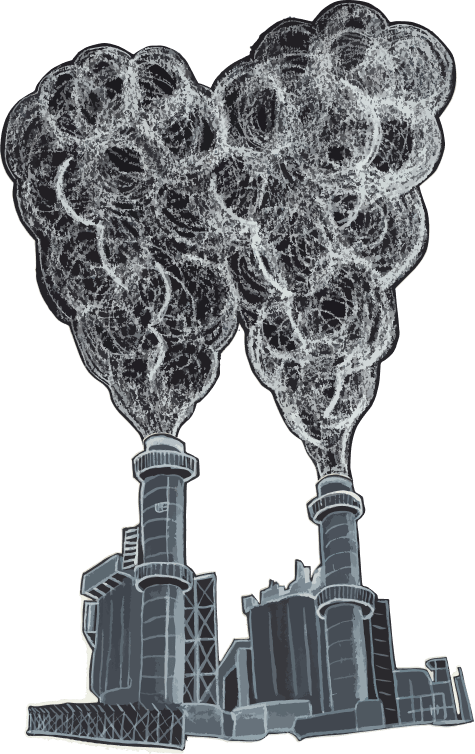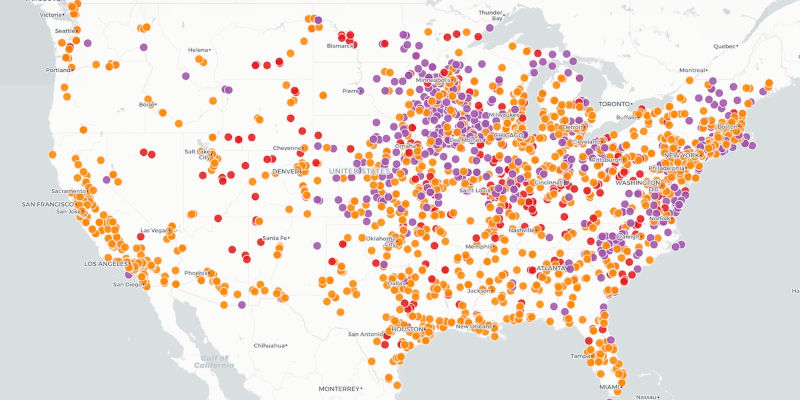Missouri
Back to mapTo get to zero by 2050, Missouri must cut emissions by 3.7% a year
Emissions in Missouri
Million metric tons of carbon dioxide (CO2) equivalent (MTCO2e
) emissions
Note: Grey area indicates missing data due to processing delays.
Source: WRI, Mar 2021
This is how we're going to do it
- Boilers and furnaces with heat pumps
- Gas stoves with electric induction stoves
- No-till farming to keep CO2 in the soil
- Capturing methane leaks from landfills
- Capturing CO2 to make emissions-free concrete
- Burning green hydrogen to make emissions-free steel
- Plugging methane leaks from gas pipelines
Decarbonize Our Buildings
8% of Missouri's climate pollution comes from buildings.
We burn fossil fuels to heat our air, water, and food.
To cut this pollution...
Let's electrify our heat!
We'll replace...
...in all of Missouri's 3.2 million buildings.
In fact, 39.6% of appliances in buildings in Missouri are already fossil fuel free!
That means we only need to electrify the remaining 1.9 million dirty buildings in Missouri. That's around 71,000 per year.
Source: Microsoft, Mar 2021; NREL, Dec 2021Electrifying all buildings cuts 8% of the pollution.
Decarbonize Our Transport
24% of Missouri's pollution comes from cars, trucks, trains, and planes.
But mostly from cars.
To cut this pollution,
your next car must be electric.
Or consider going car-free with public transit, bikes/e-bikes, car share, or other alternatives!
There are 2.0 million vehicles in Missouri and 7,000 are already electric (0.3% of the total).
We need to electrify (or replace) the remaining 2.0 million gas-powered vehicles. That's around 73,000 a year.
Source: DOT, Feb 2021Electrifying all transportation cuts 24% of the pollution.
Decarbonize Our Power
39% of Missouri's pollution comes from burning coal, gas, and oil to make power.

That's because of how power is generated in Missouri today.
Power Generation in the State of Missouri (2020)
But there's already 20% carbon-free electricity generation in Missouri!
To clean up the emissions from the polluting power plants we need to replace all fossil fuel power plants with solar and wind farms.

...and find good jobs for those workers.
Current Fossil Fuel Power Plants in Missouri
11 coal plants
2,389 MW
1,725 MW
1,300 MW
1,242 MW
1,182 MW
1,099 MW
1,046 MW
1,041 MW
603 MW
261 MW
232 MW
34 gas plants
814 MW
691 MW
630 MW
507 MW
451 MW
379 MW
351 MW
321 MW
316 MW
278 MW
262 MW
240 MW
229 MW
176 MW
163 MW
118 MW
104 MW
100 MW
85 MW
57 MW
52 MW
47 MW
45 MW
43 MW
42 MW
38 MW
38 MW
34 MW
28 MW
26 MW
13 MW
10 MW
7 MW
5 MW
26 oil plants
490 MW
68 MW
61 MW
61 MW
61 MW
38 MW
36 MW
28 MW
22 MW
17 MW
17 MW
16 MW
14 MW
14 MW
13 MW
10 MW
9 MW
8 MW
8 MW
7 MW
6 MW
6 MW
5 MW
4 MW
2 MW
2 MW
But wait!
It's not enough to replace our power plants with wind and solar farms.
To power our electric cars and buildings, we need two times the electricity we have today.
In all, we'll need to build 8,000 megawatt (MW) of wind power and 8,000 MW of solar power.
Since the average wind turbine provides 2.75 MW of peak capacity, Missouri would need to install about 3,000 turbines.
Since Missouri already has 754 MW of wind and 62 MW of solar, that's 7,000 MW of wind power we need to build and 8,000 MW of solar power. That's around 256 MW of wind power and 302 MW of solar power a year.
Source: EIA, Apr 2022Decarbonizing all dirty power cuts 39% of the pollution.
And gives us zero-emissions power we need to eliminate pollution from buildings and cars!
Other Emissions
The last 30% of Missouri's climate pollution comes from other sources...
This includes farming, landfills, industry, and leaks from gas pipelines.
There's no one solution to solve these problems, but there are lots of great ideas:
That doesn't mean there's no solution, it just means that clean electrification doesn't help with these problems, and you could fill a whole book with covering all of them. We need to encourage our politicians to invest in researching new solutions and implementing existing solutions to these problems!
Ready to do your part?
Learn how to electrify your own machines and pass local policy to electrify the rest
Take Action